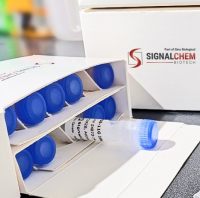Enzyme Immobilization on Microelectrode Biosensors
互联网
724
Protein immobilization is a key step in biosensor preparation that impacts on the overall performance. Among the wide variety
of immobilization techniques currently available, only a few have been reliably applied in vivo. In this chapter, we discuss
five different enzyme immobilization procedures, namely covalent immobilization by cross-linking using glutaraldehyde, poly(ethylene
glycol) diglycidyl ether (PEGDE), or a hydrogel matrix and enzyme entrapment in a sol–gel or polypyrrole-derived matrices.
We describe in detail experimental protocols for each method as applied to glucose oxidase and glutamate oxidase-based biosensors.
Enzymatic microelectrodes prepared using these five different procedures were then compared in terms of sensitivity, response
time, linear range, apparent Michaelis–Menten constant, and stability. An optimal method would ideally be nontoxic, simple,
and cheap and display high sensitivity, a large linear range, and relatively fast response time. Although there is no current
consensus on an ideal immobilization method, PEGDE and sol–gel techniques are potentially promising procedures for in vivo
laboratory studies.








